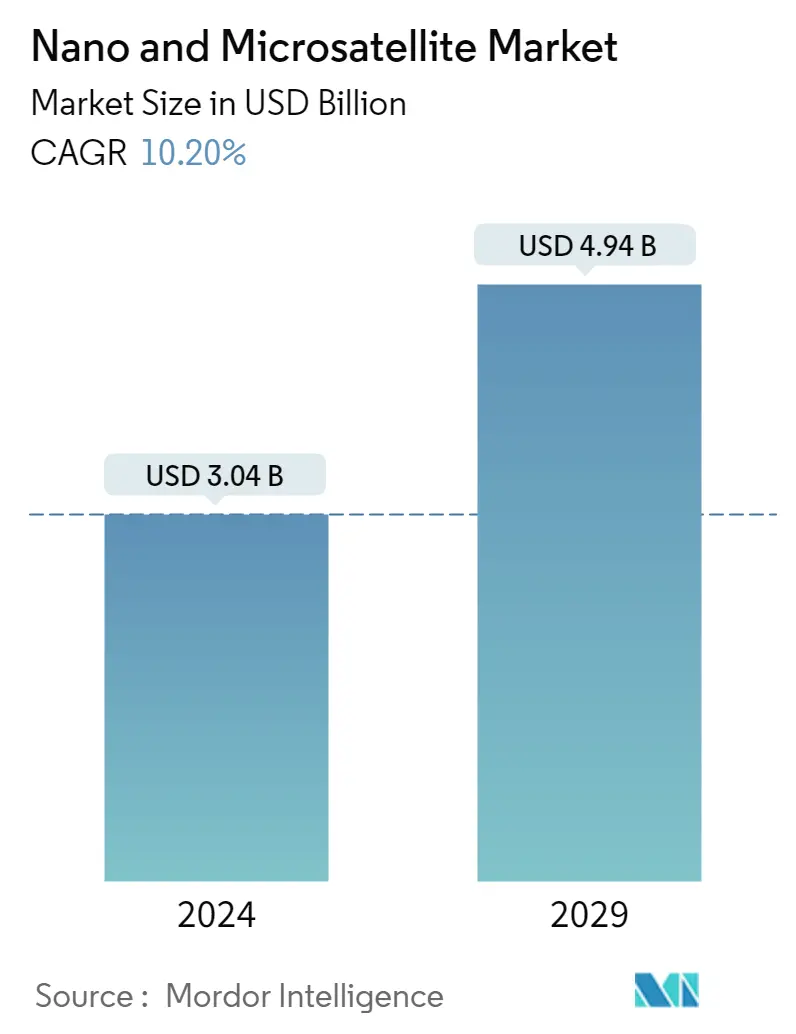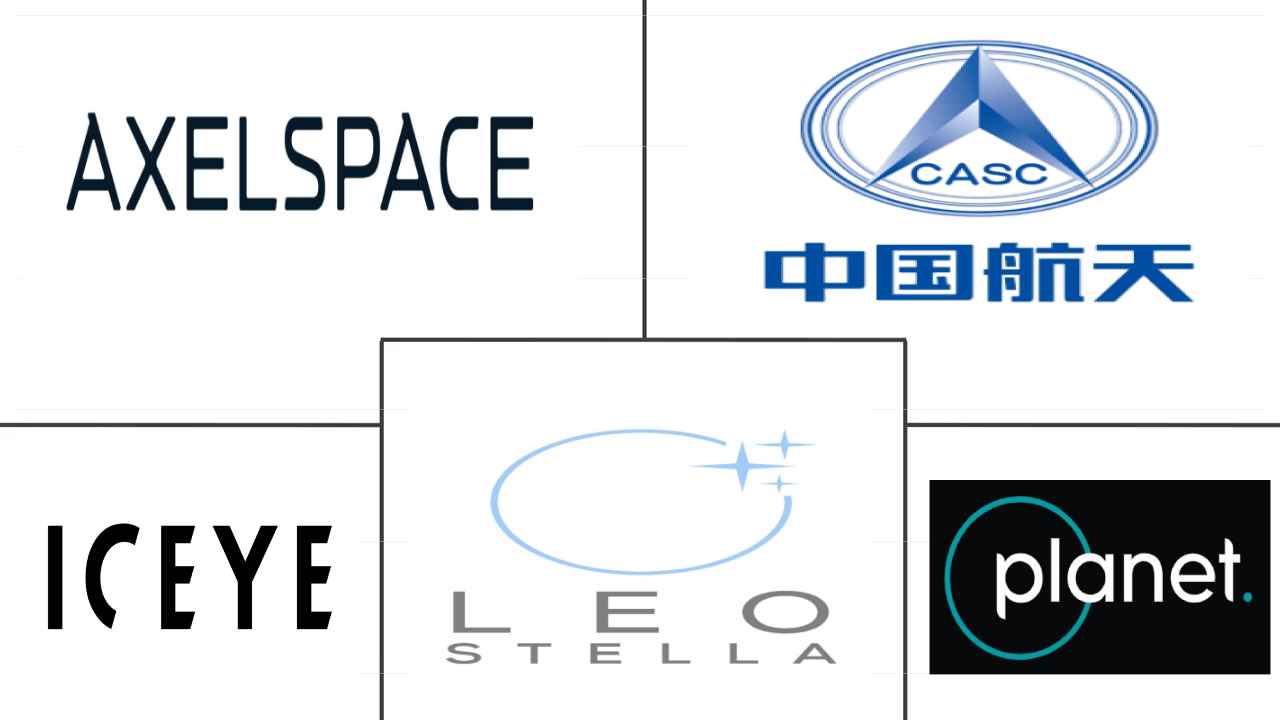Market Size of nano and microsatellite Industry

|
|
Study Period | 2017 - 2029 |
|
|
Market Size (2024) | USD 3.04 Billion |
|
|
Market Size (2029) | USD 4.94 Billion |
|
|
Largest Share by Orbit Class | LEO |
|
|
CAGR (2024 - 2029) | 10.20 % |
|
|
Largest Share by Region | Asia-Pacific |
Major Players |
||

|
||
|
*Disclaimer: Major Players sorted in no particular order |
Nano and Microsatellite Market Analysis
The Nano and Microsatellite Market size is estimated at USD 3.04 billion in 2024, and is expected to reach USD 4.94 billion by 2029, growing at a CAGR of 10.20% during the forecast period (2024-2029).
3.04 Billion
Market Size in 2024 (USD)
4.94 Billion
Market Size in 2029 (USD)
30.13 %
CAGR (2017-2023)
10.20 %
CAGR (2024-2029)
Largest Market by Propulsion Tech
73.93 %
value share, Liquid Fuel, 2022
Due to its high efficiency, controllability, reliability, and long lifespan, liquid fuel-based propulsion technology is an ideal choice for space missions. It can be used in various orbit classes for satellites.
Fastest-Growing Market by Orbit class
10.85 %
Projected CAGR, LEO, 2023-2029
LEO satellites are increasingly being adopted in modern communication technologies. These satellites serve an important role in Earth observation applications.
Largest Market by End User
81.72 %
value share, Commercial, 2022
Increasing usage of nano satellites for telecommunication services generates the need to deploy advanced communication satellites for commercial purposes thereby the requirement of these satellites has become more relevant.
Largest Market by Application
75.75 %
value share, Earth Observation, 2022
Earth observation satellites are used for weather forecasting, forestry mapping, and pollution monitoring. The growing adoption of VAS by private companies and organizations is likely to fuel the growth of satellite-based Earth observation.
Leading Market Player
10.18 %
market share, ICEYE Ltd., 2022

ICEYE Ltd is the leading player in the nano and microsatellites market. The company's satellites provide high-resolution images of the Earth's surface to help make informed decisions based on Earth observation data.
LEO Satellites Are Leading Market Demand
- During launch, a satellite or spacecraft is usually placed into one of many special orbits around the Earth, or it can be launched into an interplanetary journey. There are basically three types of Earth orbits, namely geostationary orbit (GEO), medium Earth orbit, and low Earth orbit. Many weather and communication satellites tend to have high Earth orbits, which are farthest from the surface. Satellites in medium Earth orbit include navigational and specialized satellites that are designed to monitor a specific area. Most science satellites, including NASA's Earth Observation System, are in low Earth orbit.
- The nano and microsatellite market is experiencing strong growth, driven by the growing demand for LEO satellites, which are used for communication, navigation, Earth observation, military reconnaissance, and scientific missions. Between 2017 and 2022, around 2,900 small LEO satellites were manufactured and launched from North America alone, primarily for communication applications. This has led companies such as SpaceX, OneWeb, and Amazon to plan the launch of thousands of satellites into LEO.
- In recent years, the military's use of MEO and GEO satellites has grown due to their advantages, including increased signal strength, improved communications and data transfer capabilities, and greater coverage area. For instance, Raytheon Technologies' and Boeing's Millennium Space Systems are developing the first prototype Missile Track Custody (MTC) MEO OPIR payloads to detect and track hypersonic missiles for the US Space Force.
Asia-Pacific will witness significant growth
- The global nano and microsatellite market is expected to grow significantly in the coming years, driven by increasing demand for high-speed internet, communication services, and data transfer across different industries. The market can be analyzed concerning North America, Europe, and Asia-Pacific, the major regions in terms of market share and revenue generation. During 2017-2022*, more than 800 nano and microsatellites were manufactured and launched by various operators in this segment.
- North America is expected to dominate the global geo satellite market due to several leading market players in the region, such as Planet Labs, Swarm Technologies, and SpaceX. The US government has also invested heavily in developing advanced satellite technology, which is expected to drive market growth in North America further. During 2017-2022*, the region accounted for 61% of the total nano and microsatellites manufactured.
- The nano and microsatellite market in Europe is expected to grow significantly due to the increasing demand for high-speed internet and communication services. The European Space Agency (ESA) has been investing heavily in developing advanced satellite technology, which is expected to further drive market growth in the region. During 2017-2022*, the region accounted for 5% of the total nano and microsatellites manufactured and launched.
- Asia-Pacific is expected to witness significant growth in the nano and microsatellite market due to the increasing demand for satellite-based communication services and navigation systems in countries such as China, India, and Japan.
Nano and Microsatellite Industry Segmentation
Communication, Earth Observation, Navigation, Space Observation, Others are covered as segments by Application. GEO, LEO, MEO are covered as segments by Orbit Class. Commercial, Military & Government are covered as segments by End User. Electric, Gas based, Liquid Fuel are covered as segments by Propulsion Tech. Asia-Pacific, Europe, North America are covered as segments by Region.
- During launch, a satellite or spacecraft is usually placed into one of many special orbits around the Earth, or it can be launched into an interplanetary journey. There are basically three types of Earth orbits, namely geostationary orbit (GEO), medium Earth orbit, and low Earth orbit. Many weather and communication satellites tend to have high Earth orbits, which are farthest from the surface. Satellites in medium Earth orbit include navigational and specialized satellites that are designed to monitor a specific area. Most science satellites, including NASA's Earth Observation System, are in low Earth orbit.
- The nano and microsatellite market is experiencing strong growth, driven by the growing demand for LEO satellites, which are used for communication, navigation, Earth observation, military reconnaissance, and scientific missions. Between 2017 and 2022, around 2,900 small LEO satellites were manufactured and launched from North America alone, primarily for communication applications. This has led companies such as SpaceX, OneWeb, and Amazon to plan the launch of thousands of satellites into LEO.
- In recent years, the military's use of MEO and GEO satellites has grown due to their advantages, including increased signal strength, improved communications and data transfer capabilities, and greater coverage area. For instance, Raytheon Technologies' and Boeing's Millennium Space Systems are developing the first prototype Missile Track Custody (MTC) MEO OPIR payloads to detect and track hypersonic missiles for the US Space Force.
| Application | |
| Communication | |
| Earth Observation | |
| Navigation | |
| Space Observation | |
| Others |
| Orbit Class | |
| GEO | |
| LEO | |
| MEO |
| End User | |
| Commercial | |
| Military & Government | |
| Other |
| Propulsion Tech | |
| Electric | |
| Gas based | |
| Liquid Fuel |
| Region | |
| Asia-Pacific | |
| Europe | |
| North America | |
| Rest of World |
Nano and Microsatellite Market Size Summary
The nano and microsatellite market is poised for substantial growth, driven by the increasing demand for satellites in low Earth orbit (LEO) for various applications such as communication, navigation, Earth observation, military reconnaissance, and scientific missions. The market is characterized by the rapid development and launch of small satellites, with significant contributions from major players like SpaceX, OneWeb, and Amazon. The military sector is also expanding its use of medium Earth orbit (MEO) and geostationary orbit (GEO) satellites due to their enhanced signal strength and coverage capabilities. The market's expansion is further supported by advancements in satellite technology and increased government investments in space programs across regions, particularly in North America, Europe, and Asia-Pacific.
Regionally, North America is expected to maintain a dominant position in the nano and microsatellite market, bolstered by the presence of leading companies and substantial government funding for space technology development. Europe is witnessing growth driven by the European Space Agency's investments and the rising demand for high-speed internet and communication services. Meanwhile, Asia-Pacific is experiencing significant market expansion due to the burgeoning demand for satellite-based communication and navigation systems in countries like China, India, and Japan. The market's fragmentation is evident with key players such as Axelspace Corporation, China Aerospace Science and Technology Corporation, ICEYE Ltd., LeoStella, and Planet Labs Inc. actively contributing to the industry's evolution through innovative satellite launches and technological advancements.
Nano and Microsatellite Market Size - Table of Contents
-
1. MARKET SEGMENTATION (includes market size in Value in USD, Forecasts up to 2029 and analysis of growth prospects)
-
1.1 Application
-
1.1.1 Communication
-
1.1.2 Earth Observation
-
1.1.3 Navigation
-
1.1.4 Space Observation
-
1.1.5 Others
-
-
1.2 Orbit Class
-
1.2.1 GEO
-
1.2.2 LEO
-
1.2.3 MEO
-
-
1.3 End User
-
1.3.1 Commercial
-
1.3.2 Military & Government
-
1.3.3 Other
-
-
1.4 Propulsion Tech
-
1.4.1 Electric
-
1.4.2 Gas based
-
1.4.3 Liquid Fuel
-
-
1.5 Region
-
1.5.1 Asia-Pacific
-
1.5.2 Europe
-
1.5.3 North America
-
1.5.4 Rest of World
-
-
Nano and Microsatellite Market Size FAQs
How big is the Nano and Microsatellite Market?
The Nano and Microsatellite Market size is expected to reach USD 3.04 billion in 2024 and grow at a CAGR of 10.20% to reach USD 4.94 billion by 2029.
What is the current Nano and Microsatellite Market size?
In 2024, the Nano and Microsatellite Market size is expected to reach USD 3.04 billion.

